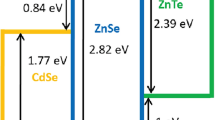Summary
A theoretical model is proposed to explain the plasma production occurring in alkali vapours irradiated by c.w. dye-lasers tuned to the resonance transition. ThenX levels, with energy nearly twice that of the excitation, are populated by the energy pooling collision between two laser-excited atoms and hence are ionized by the process of photoionization and collision with a third excited atom. The electron density is further enhanced by electronic-impact ionization from thenX levels until the stationary state of the plasma is achieved. The theoretical fluorescence behaviour of some test levels as a function of the characteristic parameters (laser power, temperature) is compared with the experimental results obtained in potassium vapours.
Riassunto
Un modello teorico è stato messo a punto per spiegare i meccanismi di produzione di plasma in vapori alcalini eccitati da laser a corrente continua sintonizzati sulla riga di risonanza. Le collisioni fra atomi eccitati popolano i livellinX di energia circa doppia dell’energia laser; successivamente tali livelli sono ionizzati attraverso meccanismi di fotoionizzazione e collisione con un atomo eccitato 4P. Gli elettroni cosí prodotti ionizzano ulteriormente i livellinX per impatto, fino a raggiungere lo stato stazionario del plasma. L’andamento teorico della fluorescenza da livelli presi come campione in funzione dei parametri caratteristici (potenza laser, temperature) è confrontato con i risultati sperimentali ottenuti in vapori di potassio.
Резюме
Предлагается теоретическая модель для обБяснения одразования плазмы в парах щелочи, облученной лазерами на красителях, настроенных на резонансный переход.nX уровни, с энергией вблизи двойного возбуждения, засэляются за счет энергии соударения, сопровождающегося группировкой, между двумя возбужденными атомами. Следовательно, происходит ионизация в результате фотоионизации и соударения с третяим возбужденным атомом. Плотность электронов дополнительно увеличивается за счет ионизации уровней при электронных соударениях, пока не достигается стационарнов состояние плазмы. Теоретическое поведение флуоресценции некоторых исследуемых уровней, как функция характеристических параметров (мощность лазера, температура), сравнивается с экспериментальными результатами, полученными в парах калия.
Similar content being viewed by others
References
M. Allegrini, G. Alzetta, A. Kopystynska, L. Moi andG. Orriols:Opt. Commun.,19, 96 (1976).
S. G. Leslie, J. T. Verdeyen andW. S. Millar:J. Appl. Phys.,48, 4444 (1977).
M. Allegrini, G. Alzetta, A. Kopystynska, L. Moi andG. Orriols:Opt. Commun.,22, 329 (1977).
G. H. Bearman andJ. J. Leventhal:Phys. Rev. Lett.,41, 1227 (1978);V. S. Kushawaha andJ. J. Leventhal:Phys. Rev. A,22, 2460 (1980).
M. E. Koch, K. K. Vernia andW. C. Stwalley:Proc. IQEC (Boston, Mass., 1980), p. 627.
M. Allegrini, P. Bicchi, S. Gozzini, I. Longo andP. Savino:Resonant laser excitation of potassium vapour: experimental laser excitation of potassium vapour: experimental investigation of energy-pooling collisions and plasma production, submitted toNuovo Cimento.
T. B. Lucatorto andT. J. McIlrath:Phys. Rev. Lett.,37, 426 (1976).
T. J. McIlrath andT. B. Lucatorto:Phys. Rev. Lett.,38, 1390 (1977);T. B. Lucatorto andT. J. McIlrath:Appl. Opt.,19, 3948 (1980).
A. C. Tam andW. Happer:Opt. Commun.,21, 403 (1977).
A. V. Hellfeld, J. Caddick andJ. Weiner:Phys. Rev. Lett.,40, 1369 (1978).
A. de Jong andF. W. der Valk:J. Phys. B,12, L561 (1979).
P. Polak-Dingels, J. F. Delpech andJ. Weiner:Phys. Rev. Lett.,44, 1663 (1980);J. Weiner andP. Polak-Dingels:J. Chem. Phys.,74, 508 (1981).
L. Marton:Methods of Experimental Physics (New York, N. Y., 1970).
G. Bekefi:Principles of Lasers Plasmas (New York, N. Y., 1976).
H. Hasted:Physics of Atomic Collisions (London, 1972).
J. M. Salter, D. D. Burgess andN. A. Ebrahim:J. Phys. B,12, L759 (1979);J. M. Slater:J. Phys. B,12, L763 (1979).
A. Klucharev, V. Sepman andV. Vujnovic:J. Phys. B,10, 715 (1977).
A. Valance:J. Chem. Phys.,69, 355 (1978).
S. Geltman:J. Phys. B,10, 3057 (1977)
J. Weiner:J. Chem. Phys.,72, 2856 (1980).
J. Krasinski, T. Stacewicz andC. R. Stroud jr.:Opt. Commun.,33, 158 (1980).
R. M. Measures andP. G. Cardinal:Phys. Rev. A,23, 804 (1981).
Author information
Authors and Affiliations
Additional information
Переведено редакцией.
Rights and permissions
About this article
Cite this article
Giammanco, F., Gozzini, S. A theoretical model for tenuous plasmas C. W. Dye-lasers produced in alkali vapours. Comparison with experimental results. Nuov Cim B 66, 47–74 (1981). https://doi.org/10.1007/BF02725481
Received:
Published:
Issue Date:
DOI: https://doi.org/10.1007/BF02725481



